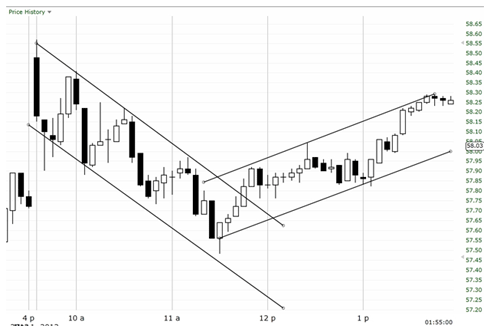The Art of Channel Trading
Some traders like to simply use one trendline, either above or below prices, depending on the trend. Another technique is to use trendlines above and below the price action in order create possible zones where prices might bounce while staying within a trend. In an earlier article we showed a chart with a big downtrend but little baby uptrends at the same time. I asked the question as to whether you should follow the bigger or smaller trends - long or short? The technique called channeling answers that question while giving you more trading opportunities.
But first, how do you make a channel? If you already know how to make a trendline the answer is simple – make 2 identical trendlines and put one above and one below the price. The slope should be exactly the same and try to do a ‘best fit’.

This is the stock Mosaic that we looked at earlier. On both my downward trend and my upward trend I used two trendlines with identical slopes. I put one above and one below the price. This provides with a zone that prices will often ping-pong up and down in while trending. This allows you to create short term profit targets. If you are trading and holding for an average of 15 minutes at a time – you’ll appreciate how channeling gives you many more opportunities to take small profits. There are many ways to play a channel when daytrading –here are two of them.
Leveraging Out of a Position
As an example, I go short at 10:30. I short with 1,000 shares. As prices near the bottom of my channel I may cover half of my position. Prices bounce up and if the downward trend is broken I will cover my remaining shares. However, shortly after 11am prices shoot down again and as it nears the bottom of the channel I cover another couple hundred shares. At this point I hang onto my final 300 shares just to ‘see what will happen’. I wait until the downward trend is broken and I cover the rest of my position.
Trading a Core Postion
Or, you might short 500 shares for the duration of the ride as your ‘core position’. Then you might play the channel with 100 or 200 shares as you short and cover (or even more risky you can add buying and selling) on the little swings inside the channel. In general you should trade (short and cover and do not buy and sell). Once you are comfortable with this sort of thing you are welcome to experiment to find your groove.

The chart above is another example of creating a channel with an upper boundary where prices might bounce back down in the short-term. You can use this as a short-term scalping target as well.
After entering a trade you should have a good idea of how far the price might go before reversing. A trailing stop-loss is OK but you’ll never quite hit the top of the profit food-chain.